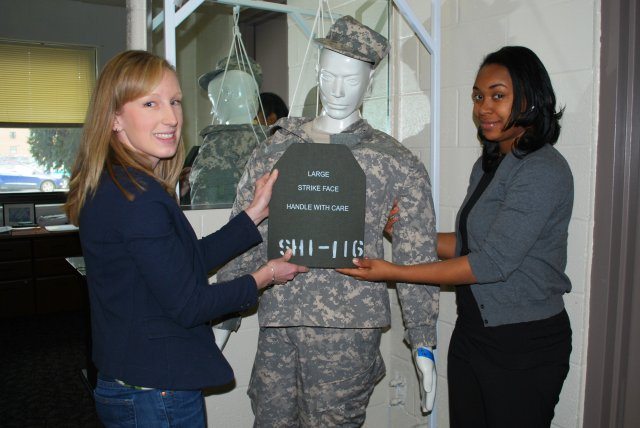Researchers from the U.S. Army Research Laboratory, or ARL continue to expand body armor analysis work to protect Soldiers – not only protecting their lives, but also their daily life functions after treatment and recovery.
The team of researchers, who work in the Warfighter Survivability Branch of ARL’s Survivability Lethality Analysis Directorate, implement methodology to better understand and analyze the protective capability of body armor, both in terms of mitigating injury and life changing outcomes. For example, eye injuries have a low level on the threat to life scale but are very significant in terms of quality of life and the Soldier’s ability to perform military tasks. The addition of new injury outcome metrics provides a method of scoring and quantifying protection in multiple meaningful dimensions.
“Current ballistic protection continues to excel at protecting our Soldiers,” said Rebecca VanAmburg, electrical engineer. “So there has been a paradigm shift not just to focus on threat to life, but other dimensions of injury as well. By performing survivability analysis that examines the multiple dimensional aspects of trauma, we can best continue to optimize how we protect and also very importantly, how we communicate these protection levels in meaningful ways.”
Soldiers’ quality of life is a major piece.
“We are using the models we already have and characterizing injury and classifying them,” said Patrick Gillich, personnel methodology team leader. “We always care about Soldiers’ threat to life – injury and loss of life, but what about quality of life and daily function? We are focusing on the simple things we all take for granted – the simple daily function tasks.”
There are four steps in the body armor analysis process. First, they look at the physical body armor and how it fits on the Soldier. Then the armor is modeled on their human model. Next, the human model fitted with body armor is modeled in a threat environment. As the final step, they perform analysis to determine the armors effectiveness in a threat environment.
Team member Latrice Hall enhanced the Army’s current methodology for performing personnel vulnerability methodology by incorporating quality of life measures. She proofed the implementation of this new analytical capability and has communicated it to DoD’s test and evaluation community.
“I implemented the metrics Rebecca uses and performed studies to help us understand the impact that the addition of new dimensions have on our analysis,” said Hall. “It’s important to perform comprehensive testing to check the quality of the outcome to ensure it’s accurate.”
The importance of this research is to continually communicate the protective capability of body armor to developers in a manner that easily quantifies the differences between systems. With their analysis, small area of coverage changes can be shown to have a significant increase in quality of life outcomes.
These analyses have been used in the decision to field Army plate carriers, neck protection, and urogenital protection.
“The reason why we do this is we want to be able to help the Soldier stay in his or her job and help them go back to their daily lives after they are injured,” said Gillich.
The team continues to focus on protecting other parts of the body, which may limit lower level injuries that have a significant effect on quality of life.
“We are also looking at other parts of the body – such as the urogenital region and the forearm,” said VanAmburg. “When evaluating the need for additional body armor we determine which metric most effectively evaluates the injuries sustained in that body area. For instance, when evaluating the need for ballistic undergarments, it was important to not only assess the injuries sustained in that body region, but also how those injuries affect the Soldier’s quality of life.”
The goal of every researcher at ARL is to ensure the Army’s Soldiers are the best trained and most lethal and well protected in the world. VanAmburg supports that goal and said, “We are using our expertise to quantify the protective capability of body armor that protects Soldiers. We are able to assess several dimensions of injury to provide meaningful analysis to the body armor community.”
ARL is part of the U.S. Army Research, Development and Engineering Command, which has the mission to develop technology and engineering solutions for America’s Soldiers.
RDECOM is a major subordinate command of the U.S. Army Materiel Command. AMC is the Army’s premier provider of materiel readiness–technology, acquisition support, materiel development, logistics power projection and sustainment–to the total force, across the spectrum of joint military operations. If a Soldier shoots it, drives it, flies it, wears it, eats it or communicates with it, AMC provides it.










